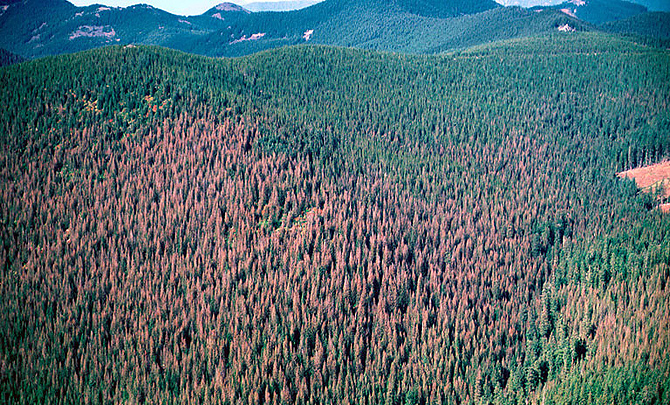Satellites Spy Beetle Attacks on Forests


A new computer program detected a slow-motion decline, and subsequent revival, of forests in the Pacific Northwest in recent years. But what was behind this mysterious pattern?
"It was, as it turns out, bugs," said Robert Kennedy, a remote sensing specialist at Boston University who designed the computer program, in a NASA statement.
Kennedy's program, called LandTrendr, can detect minute changes in the health of forests by analyzing wavelengths of light given off by the landscape and recorded in satellite images. Different types of vegetation reflect different wavelengths of light, often in ways that the naked eye can't detect.
In the case of the declining forests, Kennedy consulted with the U.S. Forest Service to confirm that the pattern of decline and rebirth detected by LandTrendr, and seen in several areas through the Northwest, was caused by mountain pine beetles. His program also detected a similar pattern of damage caused by the western spruce budworm.
Outbreaks of pine beetles have occurred in several areas, according to the release, including near Mount Hood in the 1980s, an outbreak that peaked in 1992 when the forest began to grow back. Another outbreak near Mount Rainier lasted 10 years, from its onset in 1994 until the insects killed all the trees and moved on in 2004. Pine beetles still pose a huge threat to forests throughout the West.
Kennedy's program also recognized a subtler decline of forests near these two mountains. Hiking to an area that seemed be in poor health based upon the program's analysis, Kennedy recently found an infestation of western spruce budworms. These insects eat the needles off of spruce trees. This won't kill trees immediately, but will if the insects return in following years, NASA reported.
LandTrendr is still in development, but has already changed the way the U.S. Forest Service monitors ecosystems in the Pacific Northwest, according to the NASA statement. Next, researchers aim to analyze the data in real-time, according to the release, so that, for example, they could contain an insect outbreak before it causes too much damage.
Get the world’s most fascinating discoveries delivered straight to your inbox.
Reach Douglas Main at dmain@techmedianetwork.com. Follow him on Twitter @Douglas_Main. Follow OurAmazingPlanet on Twitter @OAPlanet. We're also on Facebook and Google+.



